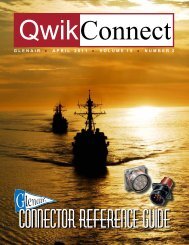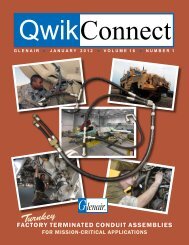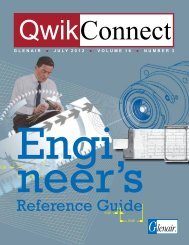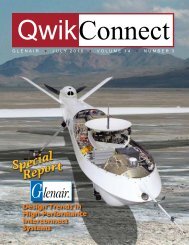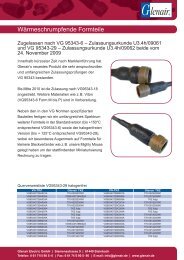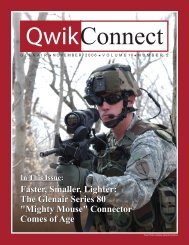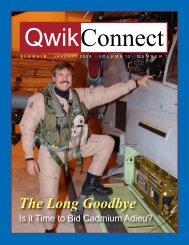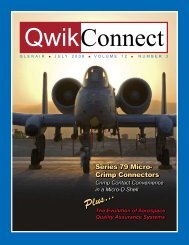April 2010 - Glenair, Inc.
April 2010 - Glenair, Inc.
April 2010 - Glenair, Inc.
You also want an ePaper? Increase the reach of your titles
YUMPU automatically turns print PDFs into web optimized ePapers that Google loves.
properties and still retain the necessary strength.<br />
The successful result was the qualification of a fire<br />
hardened pultruded decking for high traffic areas,<br />
meets Grade-B shock.<br />
Molded product is qualified for radar platforms.<br />
Following development of a suitable alternative<br />
composite material, it was necessary to address<br />
the maintenance process associated with grating<br />
repairs. An installation procedure developed and<br />
a NAVSEA standard drawing was published for<br />
the institutionalization of product. The installation<br />
of the composite grating was engineered so that<br />
it could be readily maintained in the field by nondepot<br />
level personnel or even by ship’s force. To<br />
ensure adequate strength of the attachment points<br />
without introducing a source of running rust, Type<br />
316 corrosion resistant steel (CRES) fasteners were<br />
specified.<br />
The extent of the hot work is a simple procedure<br />
of welding threaded studs in place with a stud gun.<br />
This installation scheme results in a removable deck<br />
system which now permits access to the support<br />
structure for preservation. A 60% reduction in weight<br />
(7.5 lb/ft2 versus 2.8 lb/ft2) is an additional bonus.<br />
All of these improvements were institutionalized in a<br />
standard NAVSEA Drawing for documentation of the<br />
process and the materials. 7<br />
Composite■Vent■Screens<br />
Each ship has ventilation openings in various<br />
shapes and sizes; there is no standard configuration.<br />
Traditionally, the protective screens in these<br />
openings are made from galvanized or CRES wire<br />
mesh screen. This mesh screen was typically<br />
framed by a one inch steel angle and then held<br />
in place by carbon steel fasteners. All suffer from<br />
running rust which precipitates a maintenance and<br />
cosmetic problem. The objective of this effort was to<br />
develop a replacement for the metallic screen with<br />
a fire resistant, low smoke, nontoxic combustion<br />
gas composite solution. The composite screen is<br />
a molded fiberglass product whose resin matrix,<br />
developed under the deck grating program, includes<br />
fire retardant additives. When subjected to fire<br />
insult, no toxic combustion products are produced.<br />
This type of performance is desired for the HVAC<br />
applications. A fastening scheme was developed<br />
QwikConnect<br />
using all 316 stainless steel components. The<br />
material is haze gray to match the adjacent hull<br />
coating and features UV inhibitors so that it does not<br />
need to be painted. The end result was a successful<br />
fire hardened composite material which does not<br />
corrode due to general corrosion and which does<br />
not result in galvanic corrosion due to the coupling<br />
of an anodic and a cathodic metal. The program<br />
has been so successful that a significant proportion<br />
of the square footage installed on aircraft carriers,<br />
amphibious ships and surface combatants is now<br />
installed with the composite vent screens. Further<br />
guidance for proper preservation of the areas in and<br />
10 QwikConnect n <strong>April</strong> <strong>2010</strong>



